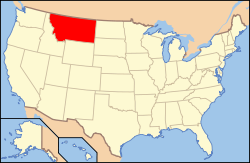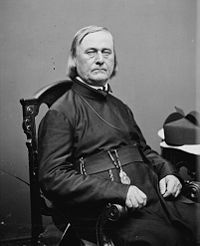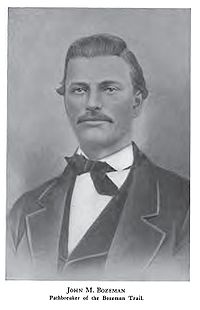- List of people in Montana history
-
-
This list is incomplete; you can help by expanding it.
Main article: History of MontanaThis is a list of notable figures in the history of pre-territorial Montana, Montana Territory and the state of Montana. Individuals listed played significant roles in the exploration and settlement of the region as well as the cultural, economic, military and political development of the territory and state.
Montana is a state located in the Western United States. Added to the U.S. in 1803 and explored by Lewis and Clark, the territory was home to numerous Indian tribes. In the mid-19th century the discovery of gold silver or copper and other minerals led to a mining boom. Settlement by farmers and ranchers began as the railroads built a network linking Montana to Minneapolis in the East, Denver and the South, and Seattle in the West. At the state has produced numerous important politicians, especially in the Democratic Party, as well as famous entrepreneurs who built the mining industry, and the numerous small cities.
Contents
Pre-territorial period
- William Clark (explorer), leader of the Lewis and Clark Expedition (1804–1806)
- Meriwether Lewis, leader of the Lewis and Clark Expedition (1804–1806)
- Henry Plummer, (1832 – 1864) served as sheriff of Bannack, Montana, from May 24, 1863 until January 10, 1864, when he was hanged without trial by the controversial vigilantes.
- Sacagawea, indian guide for Lewis and Clark Expedition (1804–1806)
- Father Pierre-Jean De Smet (30 January 1801 – 23 May 1873), also known as Pieter-Jan De Smet, was a Belgian Roman Catholic priest and member of the Society of Jesus (Jesuits), active in missionary work among the Native Americans of Western Montana in the mid-19th century.
Montana Territory (1864–1889)
Portrait of John Bozeman[1]
The Territory of Montana was an organized incorporated territory of the United States that existed from May 28, 1864, until November 8, 1889, when it was admitted to the Union as the State of Montana. This era was characterized by fighting between the Plains Indians and the U.S. Army, large-scale mining operations, large cattle up ranching operations, and the arrival of the railroads.
- John M. Bozeman, (1835–1867). In 1863, he and John Jacobs blazed the Bozeman Trail, a cutoff route from the Oregon Trail in Wyoming to Bannack, Montana, and guided miners to Virginia City through the Gallatin Valley. In 1864, he laid out the town of Bozeman, Montana.
- Lt. Colonel George Armstrong Custer, (1839–1876) was a United States Army officer and cavalry commander in the American Civil War and the Indian Wars. Defeated and killed during the Battle of the Little Bighorn in Southeast Montana. Custer's defeat made him one of the most famous military figures in American history.
- Captain Gustavus Cheyney Doane, (1840–1892) was a U.S. Army Cavalry Captain, explorer, inventor and Civil War soldier who played a prominent role in the exploration of Yellowstone as a member of the Washburn-Langford-Doane Expedition in 1871.[2]
- General Nelson A. Miles (1839 – 1925) was an American soldier who served in the American Civil War, Indian Wars, and the Spanish-American War. His command was responsible for the capture of Chief Joseph in the Bear Paw Mountains that concluded the Nez Perce War of 1877.
- Granville Stuart, (1834–1918) was a pioneer, gold prospector, businessman, civic leader, author, cattleman and diplomat who played a prominent role in the in the early history of Montana Territory and the state of Montana.[3]
- James Stuart, (1832–1873; brother of Granville) was a gold prospector, pioneer, businessman, explorer and indian agent who played a prominent role in the settlement of Montana Territory.[2]
- Nathaniel P. Langford, member of the Washburn–Langford–Doane Expedition to Yellowstone in 1871 and Virginia City, Montana vigilante.
- Henry D. Washburn, Surveyor General of Montana Territory and leader of the Washburn–Langford–Doane Expedition to Yellowstone in 1871.
- Lester S. Willson, (1839–1919) U.S. Civil War officer and merchant and politician from Bozeman, Montana.
State of Montana (19th century)
- William Horace Clagett (1838 – 1901) was Montana Territorial Congressman (1871–1872) and introduced the Act of Dedication bill into Congress that ultimately led to the creation of Yellowstone National Park.[4]
- William Andrews Clark, Sr. (1839–1925) was an American politician and entrepreneur, involved with mining, banking and railroads. He known as one of the three "Copper Kings" of Butte, Montana and was also a U.S. Senator from Montana.
- Marcus Daly, (1841–1900) was an Irish-born American businessman known as one of the three "Copper Kings" of Butte, Montana.
- Paris Gibson, (1830–1920), was an entrepreneur and Montana politician who founded Great Falls, Montana.
- James Jerome Hill, (1838–1916), was a Canadian-American railroad executive based in St. Paul, Minnesota. He headed a group of lines especiall the Great Northern Railway, which served Montana and a substantial area of the Upper Midwest, the northern Great Plains, and Pacific Northwest. Because of the size of this region and the economic dominance exerted by the Hill lines, Hill became known during his lifetime as The Empire Builder.
- Charles Marion Russell, (1864 – 1926) was an artist of the Old American West. Russell created more than 2,000 paintings of cowboys, Indians, and landscapes set in Montana in addition to bronze sculptures. Known as 'the cowboy artist',[5] Russell was also a storyteller and author. The C. M. Russell Museum Complex located in Great Falls, Montana houses more than 2,000 Russell artworks, personal objects, and artifacts.
- Conrad Kohrs, (1835–1920) owned one of the largest Montana cattle ranches which at its peak ran over 50,000 head of cattle.
- Harvey Logan (1867–1904), also known as Kid Curry, was a notorious Montana outlaw and gunman who ran with Butch Cassidy and the Sundance Kid's infamous Wild Bunch gang. He killed at least nine law enforcement officers in five different shootings, and another two men in other instances, and was involved in several shootouts with posses and civilians during his outlaw days.
- John Frank Stevens (1853–1943) was an engineer who built the Great Northern Railway and the first European American to discover the Marias Pass over the Continental Divide in 1889.
State of Montana (20th century)
- Evelyn Cameron (1868–1928) was a Terry, Montana based photographer.[6]
- George F. Grant, (1906 – 2008) was an angler, author and conservationist from Butte, Montana. He was active for many years on the Big Hole River.[7] In 1988 Grant established the Big Hole Foundation to focus conservation efforts on the river he had saved through his earlier conservation activities.
- George Bird Grinnell (1849–1938) was an anthropologist, historian, naturalist, and writer who was instrumental in the establishment of Glacier National Park.
- A. B. Guthrie, Jr., (1901 – 1991) was a novelist, historian, and literary historian who won the Pulitzer Prize for fiction in 1950 for his The Way West dealing with the Oregon Trail and the development of Montana.
- Joseph Kinsey Howard, (1906–1951) was a journalist and historian who wrote about the history, culture, and economic circumstances of Montana and the West. Howard's landmark 1943 book, Montana: High, Wide, and Handsome is an animated account of Montana history that has influenced later generations of historians.
- Michael Joseph Mansfield, (1903–2001) was a politician and the longest-serving Majority Leader of the United States Senate, serving from 1961 to 1977. Mansfield represented the state of Montana throughout his political career.
- James E. Murray (1876–1961) was a United States Senator, and a leader of the Democratic Party. He served in the United States Senate from 1934 until 1961.
- Jeannette Pickering Rankin, (1880–1973) was the first woman in the U.S. Congress, elected statewide in 1916 and again in 1940. A lifelong pacifist, she voted against the entry of the United States into both World War I and World War II, the only member of Congress to vote against the latter. To date, she is the only woman to be elected to Congress from Montana.[8]
- James Willard Schultz, or Apikuni, (1859–1947) was a noted author, explorer, Glacier National Park guide, and historian of the Blackfoot Indians.[9] Schultz is most noted for his prolific stories about Blackfoot life and his contributions to the naming of prominent features in Glacier National Park.
- Kenneth Ross Toole, (1920–1981) was an historian, author, and educator who specialized in the history of Montana. Perhaps the best-known and most influential of the state's 20th-century historians, Toole served as director of the state's historical society, authored several noted volumes of state history and social commentary, and was a popular professor at the University of Montana for 16 years.
State of Montana (21st century)
- Max Baucus, U.S. Senator, longest serving Senator from Montana (1978 to present)
See also
Notes
- ^ Hebard, Grace Raymond; Brininstool, E.A. (1922). The Bozeman Trail-Historical Accounts of the Blazing of the Overland Routes into the Northwest, and the Fights with Red Cloud's Warriors - Volume II. Cleveland: Arthur H. Clark Company. frontispiece.
- ^ a b Bonney, Orrin H.; Bonney, Lorraine (1970). Battle Drums and Geysers-The Life And Journals Of Lt. Gustavus Cheyney Doane, Soldier And Explorer Of The Yellowstone And Snake River Regions. Chicago: Swallow Press. pp. 3–158.
- ^ Milner, Clyde A.; O'Conner, Carol A. (2009). As Big As The West-The Pioneer Life of Granville Stuart. New York: Oxford Universtity Press. ISBN 9780195127096.
- ^ Ferdinand Vandeveer Hayden and the Founding of the Yellowstone National Park. Washington, D.C: United States Department of the Interior Geological Survey, U.S. Government Printing Office. 1973.
- ^ http://www.biographi.ca/009004-119.01-e.php?&id_nbr=8351 Retrieved 22-07-2009
- ^ Lucey, Donna M. (2001). Photographing Montana 1894-1928: The Life and Work of Evelyn Cameron. Missoula, Montana: Mountain Press Publishing. ISBN 0878424253.
- ^ "George Francis Grant (1906-2008): fly tyer, environmentalist, founder". http://ecorover.blogspot.com/2008/12/george-francis-grant-1906-2008-fly-tyer.html. Retrieved 2010-03-30.
- ^ "Women in Congress-Jeannette Rankin". http://womenincongress.house.gov/member-profiles/profile.html?intID=202. Retrieved 2010-09-08.
- ^ Hanna, Warren L. (1988). "James Willard Schultz-The Pikuni Storyteller". Stars over Montana-Men Who Made Glacier National Park History. Glacier Natural History Association. pp. 95–111. ISBN 091679064.
 State of Montana
State of MontanaTopics - Index
- History
- Governors
- People
- Geography
- State Government
- Delegations
- Visitor Attractions
Society - Crime
- Demographics
- Economy
- Education
- Politics
Regions - The Flathead
- Glacier National Park
- Regional designations of Montana
- Western Montana
- Yellowstone
Largest cities Counties - Beaverhead
- Big Horn
- Blaine
- Broadwater
- Carbon
- Carter
- Cascade
- Chouteau
- Custer
- Daniels
- Dawson
- Deer Lodge
- Fallon
- Fergus
- Flathead
- Gallatin
- Garfield
- Glacier
- Golden Valley
- Granite
- Hill
- Jefferson
- Judith Basin
- Lake
- Lewis and Clark
- Liberty
- Lincoln
- Madison
- McCone
- Meagher
- Mineral
- Missoula
- Musselshell
- Park
- Petroleum
- Phillips
- Pondera
- Powder River
- Powell
- Prairie
- Ravalli
- Richland
- Roosevelt
- Rosebud
- Sanders
- Sheridan
- Silver Bow
- Stillwater
- Sweet Grass
- Teton
- Toole
- Treasure
- Valley
- Wheatland
- Wibaux
- Yellowstone
Categories: -
Wikimedia Foundation. 2010.





